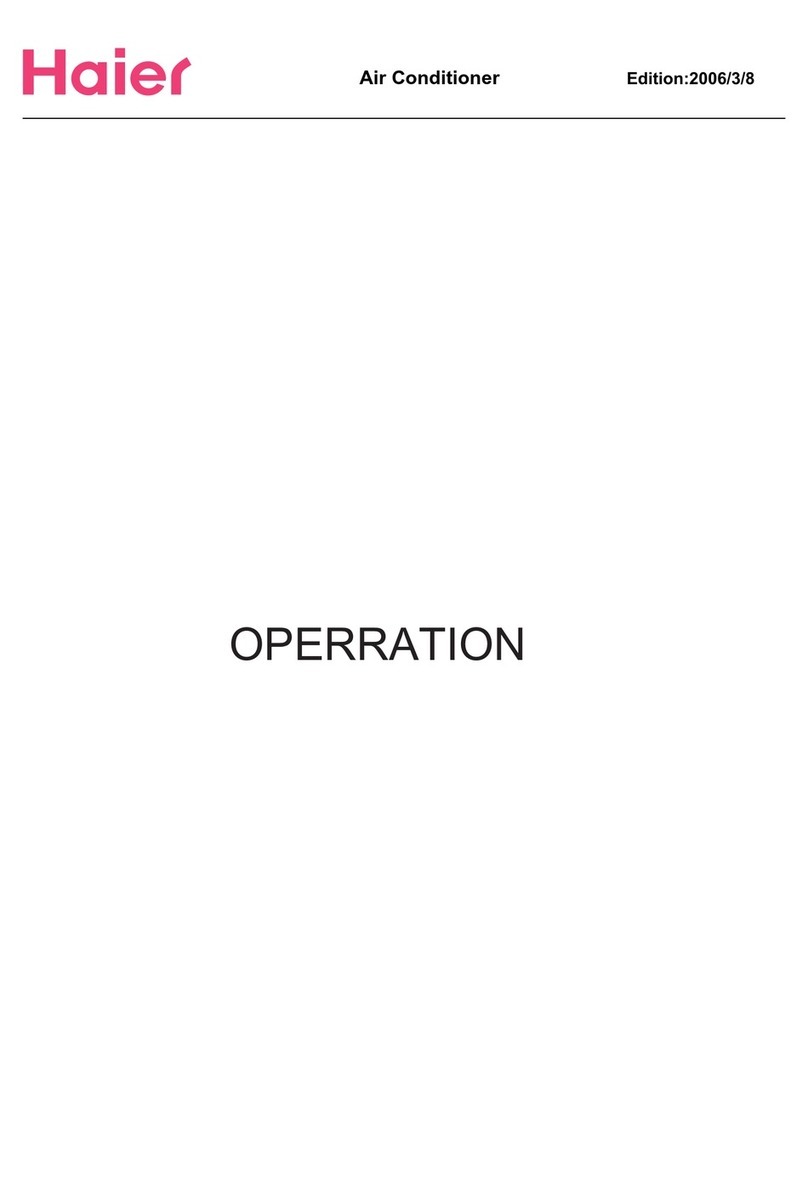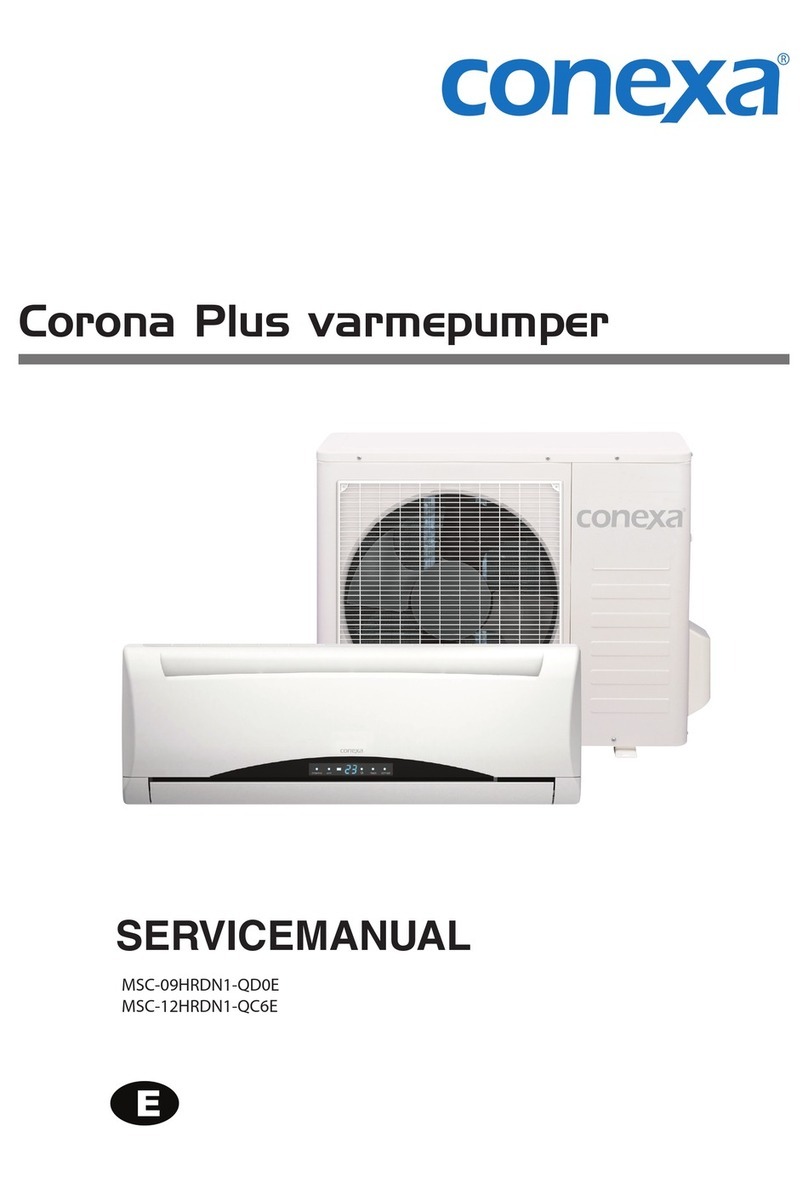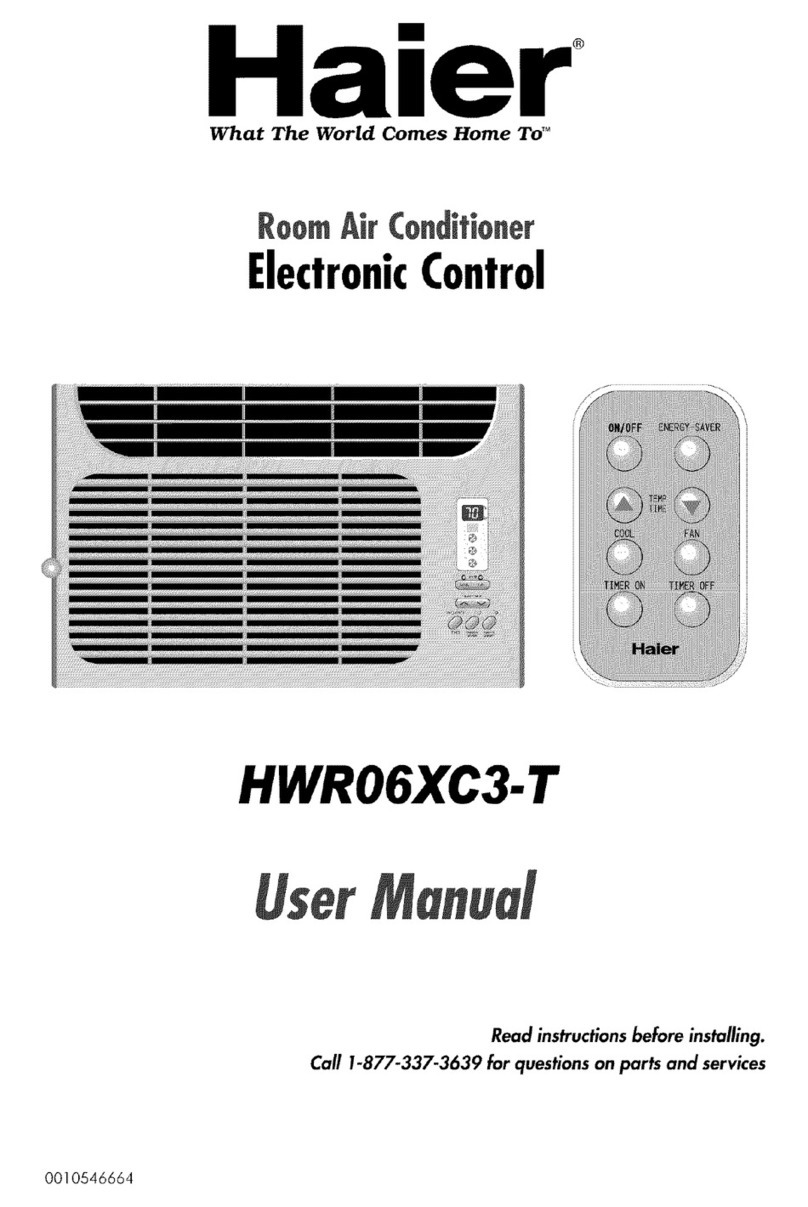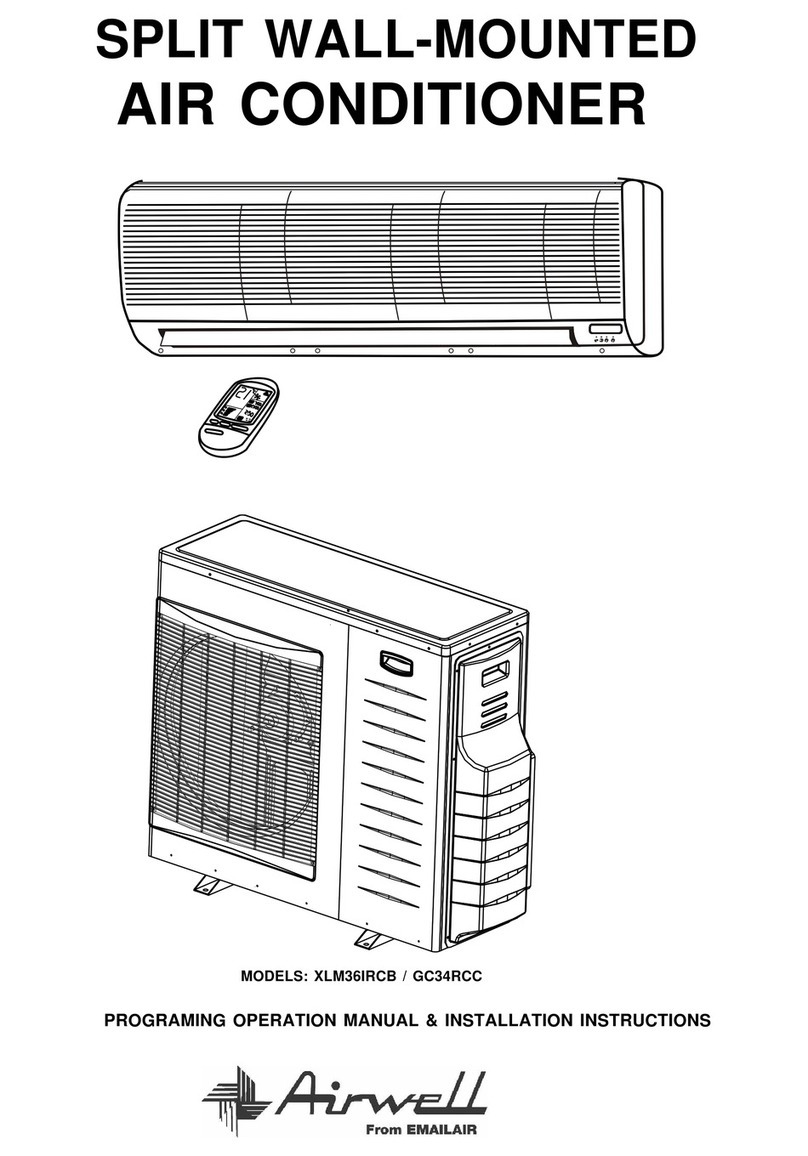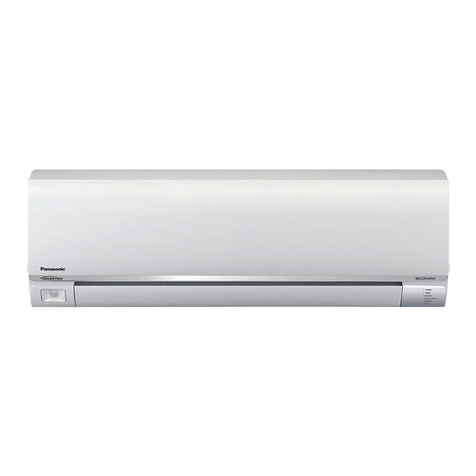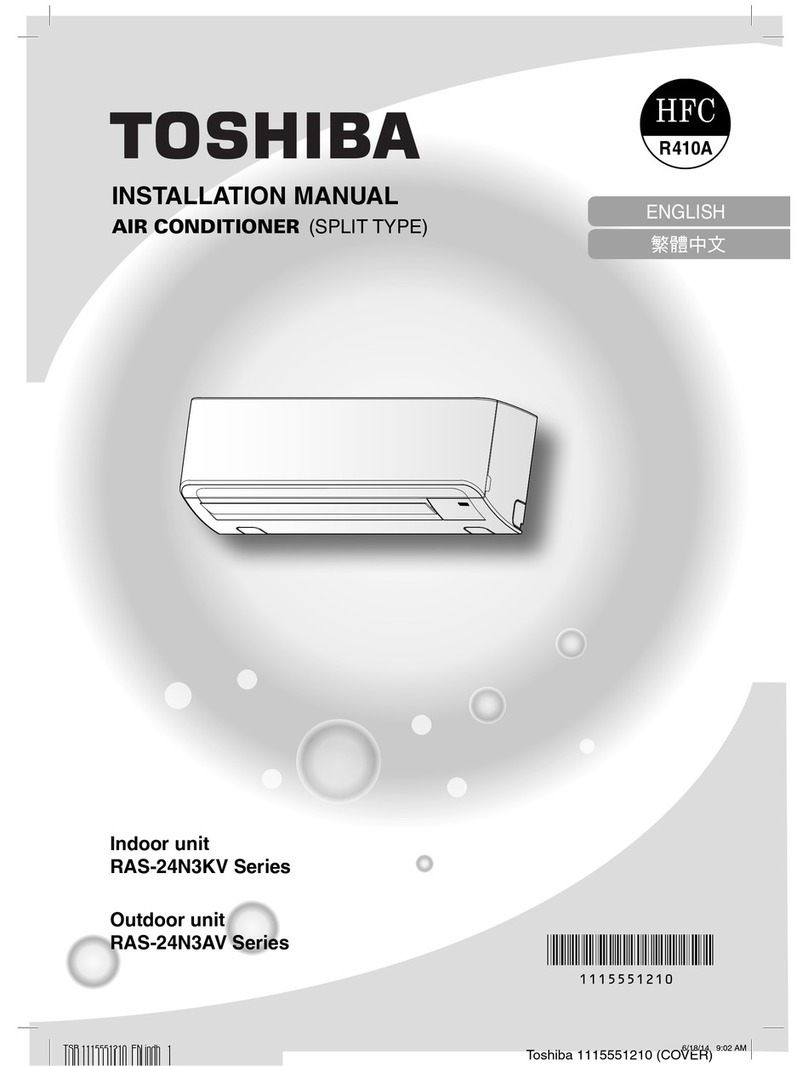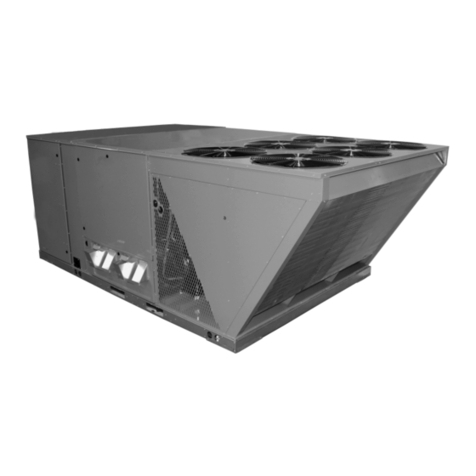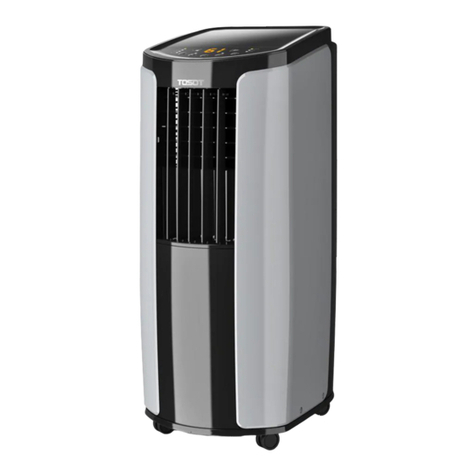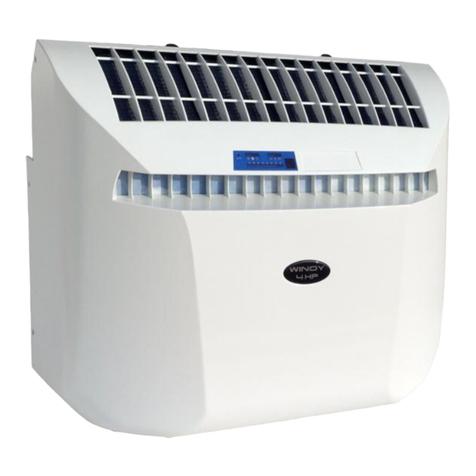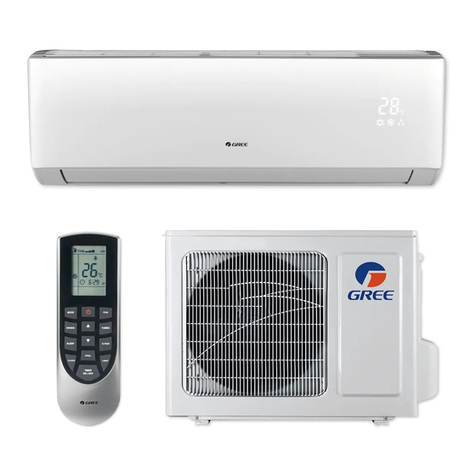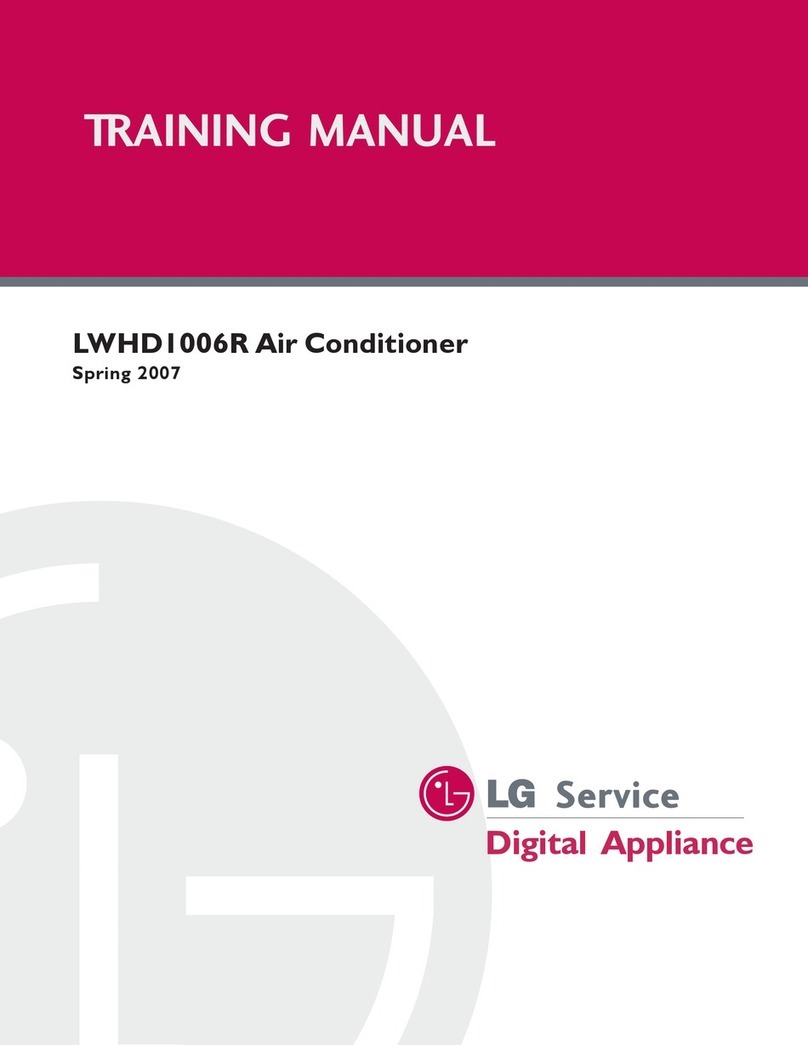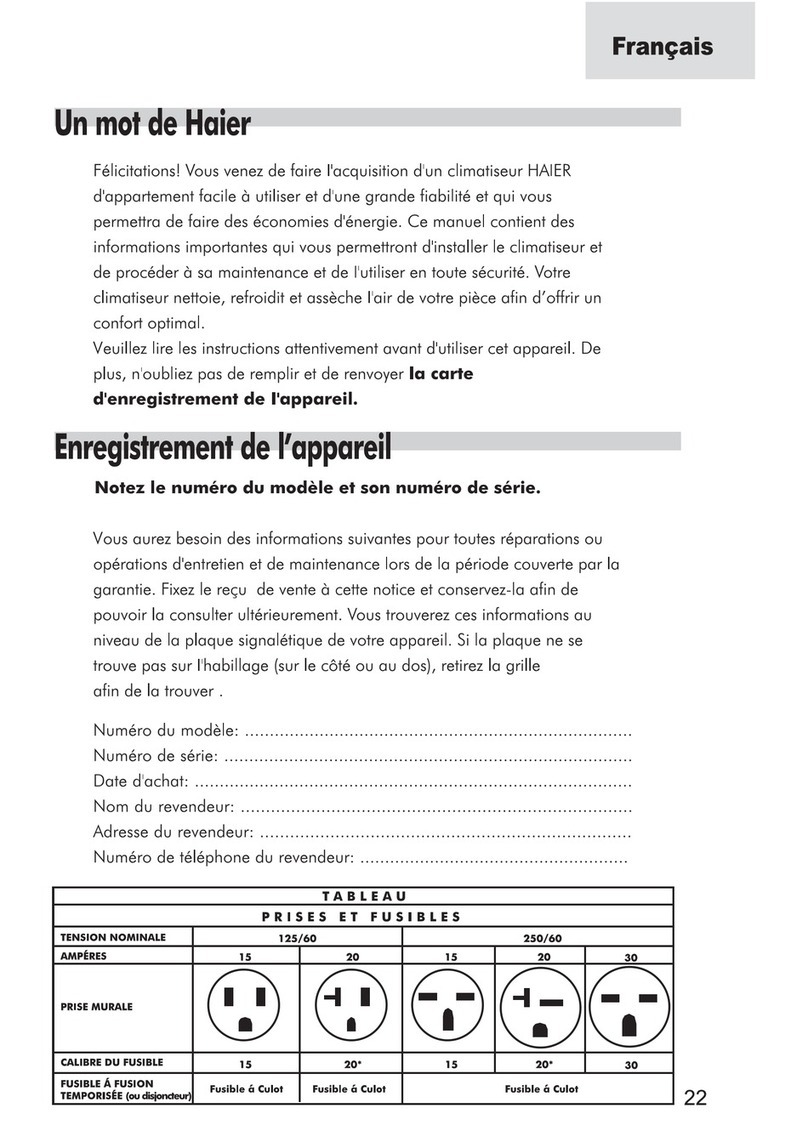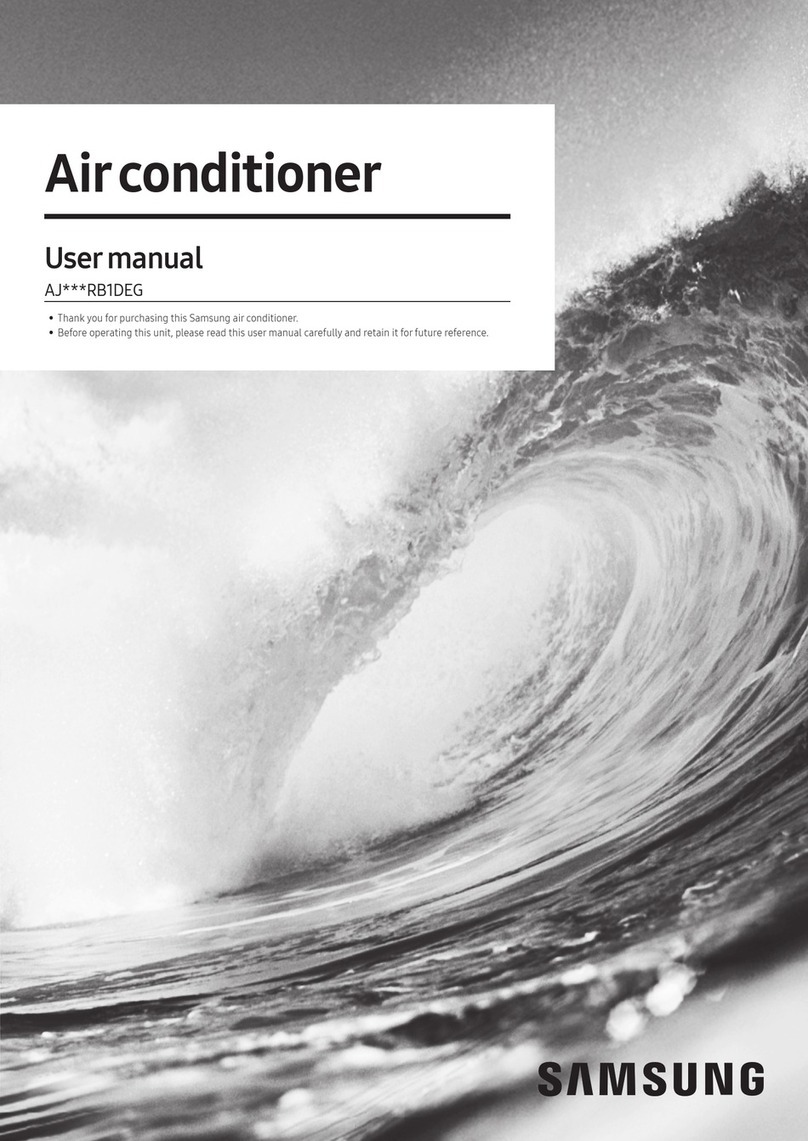Mammoth R6GD Series Manual

ATTENTION INSTALLERS:
It is your responsibility to know this product better than your customer. This includes being able to install the product according
to strict safety guidelines and instructing the customer on how to operate and maintain the equipment for the life of the product.
Safety should always be the deciding factor when installing this product and using common sense plays an important role as
well. Pay attention to all safety warnings and any other special notes highlighted in the manual. Improper installation of the unit
or failure to follow safety warnings could result in serious injury, death, or property damage. These instructions are primarily
intended to assist qualified individuals experienced in the proper installation of this appliance. Some local codes require
licensed installation/service personnel for this type of equipment. After completing the installation, return these instructions to
the customer’s package for future reference.
WARNING:
!
DO NOT DESTROY. PLEASE READ CAREFULLY AND KEEP IN A SAFE PLACE FOR FUTURE REFERENCE.
FIRE OR EXPLOSION HAZARD
• Failure to follow safety warnings exactly
could result in serious injury or property
damage.
• Installation and service must be performed
by a qualified installer, service agency or the
gas supplier.
• Do not store or use gasoline or other
flammable vapors and liquids in the vicinity
of this or any other appliance.
WHAT TO DO IF YOU SMELL GAS
• Do not try to light any appliance.
• Do not touch any electrical switch; do not
use any phone in your building.
• Leave the building immediately.
• Immediately call your gas supplier from a
neighbors phone. Follow the gas suppliers
instructions.
• If you cannot reach your gas supplier, call
the fire department.
13 SEER
Single Package Gas Heating / Electric Cooling - 3 Phase
R6GD SERIES
Premium Model Shown
USER’s MANUAL & INSTALLATION INSTRUCTIONS

2
USER INFORMATION
Important Safety Information ....................................4
Operating Instructions...............................................4
Cooling Operation .....................................................4
Heating Operation.....................................................4
Turning the Air Conditioner Off..................................4
Operating the Indoor Blower Continuously................4
Air Conditioner Maintenance.....................................4
Troubleshooting..........................................................4
WARRANTY INFORMATION
A warranty certificate with full details is included with the
AirConditioner.Carefullyreviewtheseresponsibilitieswith
yourdealerorservicecompany.Themanufacturerwillnot
be responsible for any costs found necessary to correct
problems due to improper setup, improper installation,
adjustments, improper operating procedure on the part
of the user, etc.Some specific examples of service calls
which are not included in the limited warranty are:
•Correcting wiring problems in the electrical circuit
supplying the Air Conditioner.
•Resetting circuit breakers or other switches.
•Adjusting or calibrating of thermostat.

3
IMPORTANT SAFETY INFORMATION .......................5
REQUIREMENTS & CODES.......................................6
GENERAL INFORMATION..........................................7
BeforeYou Install this Unit.........................................7
Locating the Equipment.............................................7
Heating Load ............................................................7
Combustion Air Requirements .................................7
Venting Requirements ..............................................8
Circulating Air Supply .............................................10
Air Ducts .............................................................10
Air Filter Requirements ........................................10
Unconditioned Spaces.........................................10
Acoustical Duct Work...........................................11
UNIT INSTALLATION ................................................11
Packaging Removal.................................................11
Rigging and Hoisting...............................................11
Clearances to Combustible Materials......................11
Ground Level...........................................................11
Rooftop....................................................................11
Condensate Drain ..................................................11
Horizontal to Downflow Conversion.........................11
Removal of Internal Filter Rack...............................12
Installing Filters in the Filter Rack ...........................12
Removing Filters from the Filter Rack.....................12
ELECTRICALWIRING...............................................13
Pre - Electrical Checklist .........................................13
Line Voltage.............................................................13
Grounding................................................................14
Thermostat / Low Voltage Connections...................14
Checking Heat Anticipator Settings......................15
Optional Outdoor Thermostat...............................15
Blower Speed..........................................................15
Unbalanced 3-Phase Supply Voltage......................15
Optional Humidistat.................................................16
GAS SUPPLY & PIPING............................................16
Leak Check .............................................................17
High Altitude Conversion.........................................17
Lp/Propane Gas Conversion...................................17
STARTUP & ADJUSTMENTS ...................................18
Pre - Start Checklist................................................18
Start-up Procedure..................................................18
Air Circulation.......................................................18
System Cooling....................................................18
System Heating....................................................18
Verifying & Adjusting Temperature Rise..................18
Verifying & Adjusting Firing Rate.............................19
Verifying Operation of Over-Temperature
Limit Control............................................................19
Verifying Burner Operation......................................19
Refrigerant Charging...............................................19
Manifold Pressure Adjustment ................................20
OPERATING SEQUENCE .........................................20
Heating Mode..........................................................20
Cooling Mode..........................................................21
Fan Mode................................................................21
EQUIPMENT MAINTENANCE...................................21
Cleaning of Heat Exchanger ...................................22
Cleaning of Burners ................................................22
COMPONENT FUNCTIONS......................................23
TROUBLESHOOTING ...............................................23
REPLACEMENT PARTS............................................23
FIGURES &TABLES .................................................24
Figure 10. R6GD Dimensions ..............................24
Table 9. Center of Gravity & Shipping Weights.....24
Airflow Information...................................................25
Table 10. Nominal Airflow Rates & Temp Rises ...25
Gas Information.......................................................26
Table 11. Gas Pipe Capacities.............................26
Table 12. Gas Flow Rates....................................26
Figure 11. R6GD Gas Valve Label.......................27
Electrical Information...............................................28
Figure 12.Wiring Diagram for 208/230 V Units....28
Figure 13.Wiring Diagram for 460 V Units...........29
R6GD Charging Charts...........................................30
Figure 14. Charging Chart for 3Ton Units............30
Figure 15. Charging Chart for 4Ton Units............30
Figure 16. Charging Chart for 5Ton Units............31
FRENCHTRANSLATIONS........................................32
INSTALLATION/PERFORMANCE CHECKLIST.......36
INSTALLER INFORMATION

4
USER INFORMATION
Figure 1. DigitalThermostat
Fan
Mode Temperature
Selector
System
Mode
OPERATING INSTRUCTIONS
NOTE: Thermostat styles vary. Some models may not
include the AUTO mode and others will have the AUTO
in place of the HEAT and COOL. Others may include all
three.Please refertothe thermostat manufacturer’sUser
manual for detailed programming instructions.
NOTE: If the temperature level is re-adjusted, or the
system mode is reset, the fan and compressor in the
outdoor unit may not start immediately.A protective timer
circuit holds the compressor and the outdoor fan off for
approximatelythreeminutesfollowingapreviousoperation
or the interruption of the main electrical power.
Cooling Operation
1. Set the thermostat’s system mode to COOL or AUTO
and change the fan mode to AUTO. See Figure 1.
2. Setthetemperatureselectortothedesiredtemperature
level. The outdoor fan, compressor, and blower
motor will all cycle on and off to maintain the indoor
temperature at the desired cooling level.
Heating Operation
1. Set the thermostat’s system mode to HEAT or AUTO
and change the fan mode to AUTO. See Figure 1.
2. Setthetemperatureselectortothedesiredtemperature
level.The compressor, outdoor fan, and blower motor
willcycleonandofftomaintaintheindoortemperature
at the desired heating level.
IMPORTANT SAFETY INFORMATION
Safety markings are used frequently throughout this
manualtodesignatea degreeorlevelofseriousnessand
should not be ignored.WARNING indicates a potentially
hazardous situation that if not avoided, could result in
personalinjuryordeath.CAUTIONindicatesapotentially
hazardoussituationthatifnotavoided,mayresultinminor
or moderate injury or property damage.
Turning the Unit OFF
Changethethermostat’ssystemmodetoOFFandthefan
modetoAUTO(SeeFigure1).NOTE:Thesystemwillnot
operate, regardless of the temperature selector setting.
Operating the Indoor Blower Continuously
Thecontinuousindoorbloweroperationistypicallyusedto
circulatetheindoorairtoequalizeatemperatureunbalance
due to a sun load, cooking, or fireplace operation.
Setthe thermostat fan modeto ON(Figure1).Theindoor
blower starts immediately, and will run continually until
the fan mode is reset to AUTO.
The continuous indoor blower operation can be obtained
with the thermostat system mode set in any position,
including OFF.
UNIT MAINTENANCE
Propermaintenanceismostimportanttoachievethebest
performancefromtheapplianceandshouldbeperformed
frequentlyatthebeginningofeachairconditioningseason.
WARNING:
Your equipment contains liquid and gaseous
refrigerant under pressure. Installation and
servicing shouldonlybe attemptedbyqualified,
trained personnel thoroughly familiar with the
equipment and safe responsible refrigerant
handling procedures. Failure to comply with
this warning could result in equipment damage,
personal injury, or death.
• Keep the outdoor unit clean. Hose off periodically and
keep unit fins clear of leaves and grass clippings.
• Keep the outdoor unit clear of obstructions.
DO NOT obstruct airflow with tall plants or shrubs.DO
NOT store gasoline or other flammable materials on or
near the outdoor unit.
• Never operate the appliance without a filter installed in
thereturnairduct.Inspectfiltersfrequentlyandreplace
when necessary with filter of same dimensional size.
TROUBLESHOOTING
If the unit fails to operate, check the following:
• Check the thermostat setting. Make sure the system
mode and temperature settings are correct.
• Check the electrical panel for tripped circuit breakers.
• Check the filters for dust accumulation.
• Check the outdoor unit and make sure it is clean and
not covered with grass or leaves.
• If the items above don’t resolve your problems, then
call your nearest service technician.

5
INSTALLER INFORMATION
IMPORTANT SAFETY INFORMATION
Pleasereadallinstructionsbeforeservicingthisequipment.
Pay attention to all safety warnings and any other special
notes highlighted in the manual. Safety markings are
used frequently throughout this manual to designate a
degreeorlevelof seriousness andshouldnotbeignored.
WARNINGindicatesapotentiallyhazardoussituationthat
if not avoided, could result in personal injury or death.
CAUTIONindicatesapotentiallyhazardoussituationthat
if not avoided, may result in minor or moderate injury or
property damage.
WARNING:
These units are fully charged with R-410A
refrigerant and ready for installation. When
a system is installed according to these
instructions,norefrigerantchargingisrequired.
If repairs make it necessary for evacuation
and charging, it should only be attempted by
qualified,trainedpersonnelthoroughlyfamiliar
with this equipment. Some local codes require
licensed installation service personnel to
service this type of equipment. Under no
circumstances should the homeowner attempt
to install and/or service this equipment. Failure
to comply with this warning could result in
equipment damage, personal injury, or death.
WARNING:
PROPOSITION 65 WARNING: This product
containsfiberglasswool,aproductknowntothe
state of California to cause cancer. Disturbing
theinsulationofthisproductduringinstallation,
maintenance, or repair will expose you to
fiberglass wool.
• Breathingthismaterialmaycauserespiratory
irritations or may cause lung cancer.
• Fiberglass wool may also cause eye
irritation, skin sensitization, or other allergic
responses in susceptible individuals.
• Always wear goggles, disposable gloves,
long sleeved shirt,and appropriate breathing
protection when working near this insulation.
Ifcontactwith skin occurs, wash immediately
with soap and water. In case of contact with
eyes, flush immediately with water for at
least15minutes.Contactaphysicianifneeded.
WARNING:
The information listed below and on the next
page must be followed during the installation,
service, and operation of this unit. Unqualified
individualsshouldnotattempttointerpretthese
instructions or install this equipment. Failure
to follow safety recommendations could result
in possible damage to the equipment, serious
per
sonal injury or death
.
• TheinstallationmustconformwiththeNationalFuelGas
Code (ANSI 2223.1, NFPA-54). Canadian installations
must conform with CAN/CGA-B149 installation codes.
• The installer must comply with all local codes and
regulations which govern the installation of this type
of equipment. Local codes and regulations take
precedence over any recommendations contained in
theseinstructions.Consultlocal buildingcodesand the
NationalElectricalCode(ANSICI)forspecialinstallation
requirements.
WARNING:
Improper installation, service, adjustment, or
maintenancemaycauseexplosion,fire,electrical
shockor other hazardousconditions which may
result in personal injury or property damage.
Unless otherwise noted in these instructions,
only factory authorized kits or accessories may
be used with this product.
CAUTION:
This unit uses refrigerant R-410A. DO NOT use
any other refrigerant in this unit. Use of another
refrigerant will damage the unit.
WARNING:
Shut off all electrical power to the unit before
performing any maintenance or service on the
system.Failure tocomplymayresultin personal
injury or death.
WARNING:
Do not place combustible material on or against
the unit cabinet. Do not place combustible
materials, including gasoline and any other
flammable vapors and liquids, in the vicinity of
the unit.

6
• Thisequipmentcontainsliquidandgaseousrefrigerant
underhighpressure.Installationorservicingshouldonly
beperformedbyqualified trainedpersonnelthoroughly
familiar with this type equipment.
• All electrical wiring must be completed in accordance
withlocal,stateandnationalcodesandregulationsand
with the National Electric Code (ANSI/NFPA 70) or in
CanadatheCanadianElectricCodePart1CSAC.22.1.
• Air Ducts must be installed in accordance with the
standards of the National Fire Protection Association
“Standards for Installation of Air Conditioning and
Ventilation Systems” (NFPA 90A), “Standard for
InstallationofResidenceTypeWarmAirHeatingandAir
ConditioningSystems”(NFPA90B), theseinstructions,
and all applicable local codes.
• Installthisunitonlyinalocationandpositionasspecified
on page 7. This unit is designed only for outdoor
installations and should be located with consideration
of minimizing the length of the supply and return ducts.
Consideration should also be given to the accessibility
offuel,electricpower,serviceaccess,noise,andshade.
• Before beginning the installation, verify that the unit
model is correct for the job. The unit model number
is printed on the data label. Follow all precautions in
the literature, on tags, and on labels provided with
the equipment. Read and thoroughly understand
the instructions provided with the equipment prior to
performing the installation and operational checkout of
the equipment.
• Use only with the type of gas approved for this unit.
Refer to the unit rating plate.
• Provide adequate combustion and ventilation air to the
unit. See pages 7 - 9.
• Provideadequateclearancesaroundtheairventintake
terminal. See page 8.
• Combustion products must be discharged outdoors.
Connect this unit to an approved vent system only, as
specified on page 8.
• Never test for gas leaks with an open flame. Use a
commercially available soap solution to check all
connections (See page 17).
• ConsultTable 10 (page 25), and the rating plate for the
proper circulating air flow and temperature rise. It is
important that the duct system be designed to provide
the correct flow rates and external pressure rise. An
improperlydesignedductsystemcanresultinnuisance
shutdowns, and comfort or noise issues.
• Installationofequipmentmayrequirebrazingoperations.
Installer must comply with safety codes and wear
appropriate safety equipment (safety glasses, work
gloves,fire extinguisher, etc.) whenperforming brazing
operations.
• ThisequipmentisNOTtobeusedfortemporaryheating
of buildings or structures under construction.
REQUIREMENTS AND CODES
This unit must be installed in accordance with
instructions outlined in this manual, all applicable
local building codes, and the current revision of the
National Fuel Gas Code (NFPA54/ANSI Z223.1) or
the Natural Gas and Propane Installation Code,CAN/
CGA B149.1.
Additional codes listed below are for reference purposes
onlyand donot necessarily havejurisdictionoverlocal or
statecodes.Localcodesandregulationstakeprecedence
overanyrecommendationscontainedintheseinstructions.
Always consult with local authorities before installing any
gas appliance.
Combustion andVentilation Air
• US:NationalFuelGasCode(NFGC),AirforCombustion
and Ventilation
• CANADA:NaturalGasandPropaneInstallationCodes
(NSCNGPIC), Venting Systems and Air Supply for
Appliances
Duct Systems
• US and CANADA: Air Conditioning Contractors
Association (ACCA) Manual Q, Sheet Metal and
Air Conditioning Contractors National Association
(SMACNA), or American Society of Heating,
Refrigeration, and Air Conditioning Engineers
(ASHRAE) Fundamentals Handbook
Electrical Connections
• US: National Electrical Code (NEC) ANSI/NFPA 70
• CANADA: Canadian Electrical Code CSA C22.1
Gas Piping and Gas Pipe PressureTesting
• US: NFGC and National Plumbing Codes
• CANADA: NSCNGPIC
General Installation
• US:CurrenteditionoftheNFGCandtheNFPA90B.For
copies,contacttheNationalFireProtectionAssociation
Inc.,BatterymarchPark,Quincy,MA02269;orAmerican
GasAssociation,400 N.Capitol,N.W.,WashingtonDC
20001 or www.NFPA.org.
• CANADA: NSCNGPIC. For a copy, contact Standard
Sales, CSA International, 178 Rexdale Boulevard,
Etobicoke (Toronto), Ontario, M9W 1R3 Canada
Safety
• US: (NFGC) NFPA 54–1999/ANSI Z223.1 and the
Installation Standards, Warm Air Heating and Air
Conditioning Systems ANSI/NFPA 90B.
• CANADA: CAN/CGA-B149.1–and .2–M00 National
Standard of Canada. (NSCNGPIC)

7
GENERAL INFORMATION
TheR6GDSinglePackageGasHeating/ElectricCooling
Unit is designed only for outdoor rooftop or ground level
installations and can be readily connected to the high
static duct system of a home.This unit has been tested
for capacity and efficiency in accordance with A.R.I.
Standards and will provide many years of safe and
dependable comfort, providing it is properly installed
and maintained. With regular maintenance, this unit will
operatesatisfactorilyyearafteryear.Abuse,improperuse,
and/or improper maintenance can shorten the life of the
appliance and create unsafe hazards.
Toachieveoptimumperformanceandminimizeequipment
failure, it is recommended that periodic maintenance be
performed on this unit. The ability to properly perform
maintenance on this equipment requires certain tools
and mechanical skills.
Before you install this unit
The cooling load of the area to be conditioned must be
calculatedandasystemofthepropercapacityselected.
It is recommended that the area to be conditioned be
completely insulated and vapor sealed.
Checktheelectricalsupply and verifythe powersupply
is adequate for unit operation.Consideration should be
given to availability of electric power, service access,
noise, and shade. If there is any question concerning
the power supply, contact the local power company.
Allunitsaresecurelypackedatthetimeofshipmentand
upon arrival should be carefully inspected for damage
prior to installing the equipment at the job site. Verify
coil fins are straight.If necessary, comb fins to remove
flattened or bent fins. Claims for damage (apparent or
concealed)should befiledimmediately withthe carrier.
Survey the job site to determine the best location for
mounting the outdoor unit. Choose an appropriate
location that minimizes the length of the supply and
return air ducts.
The indoor unit (air handler, furnace, etc) should be
installed before routing the refrigerant tubing. Refer
to the indoor unit’s instruction manual for installation
details.
Pleaseconsultyourdealerformaintenanceinformation
and availability of maintenance contracts. Please read
all instructions before installing the unit.
Locating the Equipment
• Select a solid, level position, preferably on a concrete
slab, slightly above the grade level, and parallel to the
home. DO NOT PLACE UNIT UNDERTHE HOME.
• Overhead obstructions, poorly ventilated areas, and
areas subject to accumulation of debris should be
avoided. Do not place the unit in a confined space or
recessed area where discharge air from the unit to re-
circulate into the condenser air inlet, through the coil.
• Sufficientclearanceforunobstructedairflowthroughthe
louveredcontrolaccesspanel andoutdoorcoilmustbe
maintained in order to achieve rated performance.See
Figure 2 for minimum clearances to obstructions.
• Aclearanceofatleast36inchesfromthebloweraccess
panel and from the louvered control access panel is
recommended for servicing and maintenance. Where
accessibilitytocombustiblesclearancesaregreater
thanminimumclearances,accessibilityclearances
must take preference.
• Thehotcondenserairmustbedischargedupandaway
from the home, and if possible, in a direction with the
prevailing wind.
• If practical, place the air conditioner and its ducts in an
areawheretheywillbeshaded fromtheafternoonsun,
when the heat load is greatest.
Combustion Air Requirements
WARNING:
Installationmethodsotherthanthosedescribed
in the following sections must comply with the
National Fuel Gas Code and all applicable local
codes for providing sufficient combustion air to
the furnace.
Provisions must be made during the installation of this
unitthatprovideanadequatesupplyofairforcombustion.
• Instructions for determining the adequacy of an
installation can be found in the current revision of the
NFGC (ANSI Z223.1 / NFPA54).Consult local codes
for special requirements.Theserequirements are for
US installations as found in the NFGC.
Minimum Required
Clearances to Combustibles
0"
36"
36"
36"
TOP OF UNIT
TO BE
UNOBSTRUCTED
36” For Coil Only
Figure 2. Clearance Requirements
Heating Load
This unit should be sized to provide the design heating
load requirement. Heating load estimates can be made
using approved methods available from Air Conditioning
Contractors of America (Manual J); American Society of
Heating, Refrigerating, and Air Conditioning Engineers;
orother approvedengineering methods.Forinstallations
above 2,000 ft., the unit should have a sea level input
rating large enough that it will meet the heating load after
deration for altitude.

8
A vent cover assembly has been supplied with the unit.
and can be found secured to the gas controls within the
control area of this unit.The vent cover assembly must
be installed to assure proper operation of the unit.
The following list summarizes the requirements for the
location of the vent system termination:
• Thelocation of theventtermination mustbe consistent
withtheNationalFuelGasCode(ANSIZ223.1)orCAN/
CGA-B149 Installation Codes.
• The vent termination must be located at least 4 feet
horizontally from any electric meters, gas meters,
regulators, and relief equipment.
• The vent termination must be located at least 3 feet
above any forced air inlet located within 10 feet.
• The vent termination must be located at least 4 feet
below,4feethorizontallyfrom,or1footaboveanydoor,
window, or gravity air inlet into any building.
• The vent termination must be located at least 1 foot
above grade.
• The unit should be installed in a way that prevents any
obstructionoftheventterminationduringaccumulating
snow.
• Theunitinstallationshallavoidareaswherecondensate
drainage may cause problems by dropping on planters
or patios, etc. Also verify exhaust gases will not
impinge on windows or building surfaces, which may
be compromised or damaged by condensation.
• Do not install the unit such that exhaust from the vent
termination is directed into window wells, stairwells,
under decks, or in alcoves or similarly recessed areas.
The vent termination must not be located above any
public walkways.
Figure 3 shows the proper installation of the vent cover
assembly over the vent outlet on the exterior of the
cornerpanel.Thefastenersusedtosecuretheventcover
assembly have been included in the owner’s package.
• The requirements in Canada (B149.1) are structured
differently. Consult with B149.1 and local code officials
for Canadian installations.
Airopeningsinthedooroftheunit,warmairregisters,and
return air grilles must never be restricted.If the unit does
not receive an adequate supply of air for combustion, the
flameroll-outcontrollocated abovetheburnerswillopen,
turningoffthegassupplytotheburners.Thissafetydevice
is a manually reset switch.IMPORTANT NOTE: DO NOT
install jumper wires across this control to defeat its
function or reset the control without identifying and
correcting the fault condition.
Ifthiscontrolmustbereplaced,useonlyfactoryauthorized
replacement parts. See the Replacement Parts List on
page 23.
WARNING:
Combustible air must not be drawn from a
contaminated atmosphere. Excessive exposure
to contaminated combustion air will result in
safety and performance related problems.
To maximize heat exchanger life, the combustion air
must be free of chemicals that can form corrosive acidic
compoundsinthe combustiongases.The recommended
source of combustion air is to use clean air from outside.
DONOTplaceanychemicalswithflammableorcaustic
vapors or these other corrosive chemicals near the
vent termination:
• Gasoline/Kerosene
• Permanent wave solutions
• Chlorinated waxes and cleaners
• Chlorine based swimming pool chemicals
• Water softening chemicals
• De-icing salts or chemicals
• Carbon tetrachloride
• Halogen type refrigerants
• Cleaning solvents
• Cements, glues, paint removers, varnishes, etc.
• Hydrochloric acid
• Masonry acid washing materials
• Plumbing Stack
Figure 3.Vent Assembly
Venting Requirements
This unit has been equipped with an integral venting
system and designed to operate only with this venting
system. No additional venting shall be used. This unit
must be vented to the outdoors.
WARNING:
This unit is intended for outdoor installation
only.Donot ventthe unitthrougha conventional
venting system.

9
WARNING:
CARBON MONOXIDE POISONING HAZARD
Failure to follow the steps outlined below
for each appliance connected to the venting
systembeingplacedintooperationcouldresult
in carbon monoxide poisoning or death. The
following steps shall be followed with each
individual appliance connected to the venting
system being placed in operation, while all
other appliances connected to the venting
system are not in operation:
1. Seal any unused openings in the venting
system.
2. Inspecttheventingsystemforpropersizeand
horizontalpitch,asrequiredintheNationalFuel
Gas Code, ANSI Z223.1/NFPA 54 or the CSA
B149.1, Natural Gas and Propane Installation
Codes and these instructions. Determine that
there is no blockage or restriction, leakage,
corrosion and other deficiencies which could
cause an unsafe condition.
3. As far as practical, close all building doors
andwindows andalldoorsbetweenthe space
in which the appliance(s) connected to the
venting system are located and other spaces
of the building.
4. Close fireplace dampers.
5. Turn on clothes dryers and any appliance not
connected to the venting system. Turn on
any exhaust fans, such as range hoods and
bathroom exhausts, so they are operating at
maximum speed. Do not operate a summer
exhaust fan.
6. Follow the lighting instructions. Place the
appliance being inspected into operation.
Adjustthethermostatsoapplianceisoperating
continuously.
7. Test for spillage from draft hood equipped
appliances at the draft hood relief opening
after 5 minutes of main burner operation. Use
the flame of a match or candle.
8. If improper venting is observed during any of
the above tests, the venting system must be
correctedinaccordancewiththeNationalFuel
Gas Code, ANSI Z223.1/NFPA 54 and/or CSA
B149.1, Natural Gas and Propane Installation
Codes.
9. Afterithasbeendeterminedthateachappliance
connectedtotheventingsystemproperlyvents
when tested as outlined above, return doors,
windows,exhaustfans,fireplacedampersand
any other gas-fired burning appliance to their
previous conditions of use.
AVERTISSEMENT:
RISQUE D’EMPOISONNEMENT AU
MONOXYDE DE CARBONED
Le non-respect des consignes suivantes portant
sur chacun des appareils raccordés au système
d’évacuation mis en service pourrait entraîner
l’empoisennement au monoxyde de carbone ou
la mort. Les consignes suivantes doivent être
observées pour chaque appareil raccordé au
système d’évacuation mis en service si les autres
appareils raccordés au système ne sont pas en
service:
1.
Scellertouteouverturenonutiliséedelasystéme
d’évacuation;
2.
S’assurerquelasystémed’évacuationprésente
des dimensions et une pente horizontale
conformes à la norme ANSI Z223.1/NFPA
54, intitulée National Fuel Gas Code ou aux
codes d’installation CSA-B149.1, ainsi qu’aux
présentesinstructions.S’assurerquelasystéme
d’évacuation n’est pas bloquée, restreinte,
corrodée,qu’ellenefuitpasetqu’elleneprésente
aucun autre défaut potentiellement dangereux;
3.
Dans la mesure du possible, fermer toutes les
portes et fenêtres du bâtiment, et toutes les
portes entre la pièce où se trouve l’appareil
raccordéàlasystémed’évacuationetlesautres
pièces du bâtiment.
4.
Fermer les registres des foyers;
5.
Mettre en service les sécheuses et tout autre
appareil qui n’est pas raccordé à la systéme
d’évacuation. Faire fonctionner à régime
maximal tout ventilateur d’évacuation, tel que
les hottes de cuisinière et les ventilateurs de
salles de bains. Ne pas mettre en service les
ventilateurs d’été.
6.
Respecterlesinstructionsd’allumage.Mettreen
service l’appareil à l’essai. Régler le thermostat
de manière à ce que l’appareil fonctionne sans
interruption;
7.
Vérifier s’il y a débordement à l’orifice
d’évacuationducoupetiragedesappareilsdotés
d’un coupe tirage 5 minutes après l’allumage
du brûleur principal. Utiliser la flamme d’une
allumette ou d’une chandelle.
8.
Si l’on constate, au cours de l’un des essais
qui précèdent, que l’évacuation est déficiente,
corrigerlesystèmed’évacuationconformément
à la norm ANSI Z223.1/NFPA 54, National Fuel
Gas Code, et (ou) aux codes d’installation CSA
B149.1.
9.
Après avoir déterminé que tous les appareils
raccordés à la systéme d’évacuation évacuent
correctement tel que prescrit ci-dessus,
rouvrir les portes et les fenêtres et remettre les
ventilateursd’évacuation,lesregistresdefoyers
et tout autre appareil fonctionnant au gaz à leur
état de fonctionnement initial.

10
Circulating Air Supply
WARNING:
Products of combustion must not be allowed to
enterthereturnairductworkorthecirculatingair
supply.Failuretopreventproductsofcombustion
from being circulated into the living space can
createpotentiallyhazardousconditionsincluding
carbon monoxide poisoning that could result in
personal injury or death.
All return ductwork must be adequately sealed,
all joints must be taped, and the ductwork must
be secured to the unit with sheet metal screws.
When return air is provided through the bottom
of the unit, the joint between the unit and the
return air plenum must be air tight.
The roof curb or cement pad on which the unit is
mountedmustprovidesoundphysicalsupportof
theunitwithnogaps,cracks,orsaggingbetween
the unit and the curb or pad.
Return air and circulating air ductwork must not
beconnectedtoanyotherheatproducingdevice
such as a fireplace insert, stove, etc. Doing so
may result in fire, explosion, carbon monoxide
poisoning, personal injury, or property damage.
Air Ducts
Thisunit isdesigned only for usewith asupply and return
duct.Air ducts should be installed in accordance with the
standards of the National Fire Protection Association
“Standard for Installation of Air Conditioning Systems”
(NFPA 90A),“Standard forInstallation ofResidenceType
Warm Air Heating and Air Conditioning Systems” (NFPA
90B),andallapplicablelocalcodes.NFPApublicationsare
availablebywritingto:NationalFireProtectionAssociation,
BatterymarchPark,Quincy,ME02269orvisitwww.NFPA.
org on the web.
• Design the duct work according to Manual D by the Air
Conditioning Contractors of America (ACCA).
• The ducts must be properly sized and not exceed 0.2”
W.C. pressure drop at 400 scfm per nominal ton of
cooling capacity.
• Ductworkshouldbeattacheddirectlytotheunitflanges
for horizontal applications.
• If roof curb is installed, the ducts must be attached to
the curb hangers, not the unit.
• It is recommended that the outlet duct be provided
with a removable access panel. The opening should
be accessible when the unit is installed in service and
shall be sizes so that smoke or reflected light may be
observed inside the casing to indicate the presence of
leaks in the heat exchanger.The cover for the opening
shall be attached in a way that will prevent leaks.
• If outside air is utilized as return air to the unit for
ventilation or to improve indoor air quality, the system
must be designed so that the return air to the unit is
not less than 50° F (10° C) during heating operation.
• If a combination of indoor and outdoor air is used, the
ductsanddampersystemmustbedesignedsothatthe
return air supply tothe furnaceisequal to thereturn air
supply under normal, indoor return air applications.
Air Filter Requirements
WARNING:
Never operate the unit without a filter in place.
Dustandlintcouldaccumulateoninternalparts,
resultinginlossofefficiency,equipmentdamage
and possible fire.
• A suitable air filter must be installed upstream of the
evaporator coil of the return air system. Refer toTable
1for recommended filter sizes.
• Allreturnairmustpassthroughthefiltersbeforeentering
the evaporator coil.It is important that all filters be kept
cleanandreplacedfrequentlytoensureproperoperation
of unit.Dirty or clogged filters will reduce the efficiency
of the unit and result in unit shutdowns.
• Air filter pressure drop must not exceed 0.08 inchesWC.
• DownflowInstallationsrequireaninternalfilteraccessory
kit to be installed.
• Horizontal Installations require the air filter system be
installed in the return air ductwork.
NOTETOINSTALLER:Afterinstallingorreplacingthe
filtrationsystemforthisunit,addthefollowingstatement
on or adjacent to the filter service panel: “Replace
filter(s)installedinyoursystemonlywiththesame
dimensional size filters that are being replaced.”
Table 1. Air Filter Requirements
Nominal
Cooling
(Tons)
Approximate
Air Flow
Range (CFM)
Approximate
Filter Area
(Sq. In.)*
Recommended
Filter Size
(In. x In.)
3.0 1,100 - 1,300 625 25 x 25
4.0 1,400 - 1,800 850 18 x 24 (2 required)
5.0 1,800 - 2,200 1,000 20 x 25 (2 required)
* Based on velocity of 300 ft/min for disposable filters and
500 ft/min for high velocity (cleanable) Filters.
Unconditioned Spaces
All duct work passing through unconditioned space must
beproperlyinsulatedtominimizeductlossesandprevent
condensation.Use insulation with an outer vapor barrier.
Refer to local codes for insulation material requirements.

11
Acoustical Duct Work
Certain installations may require the use of acoustical
lining inside the supply duct work.
• Acoustical insulation must be in accordance with the
currentrevisionoftheSheetMetalandAirConditioning
ContractorsNationalAssociation(SMACNA)application
standard for duct liners.
• Duct lining must be UL classified batts or blankets with
a fire hazard classification of FHC-25/50 or less.
• Fiber duct work may be used in place of internal duct
liners if the fiber duct work is in accordance with the
current revision of the SMACNA construction standard
on fibrous glass ducts. Fibrous duct work and internal
acoustical lining must be NFPA Class 1 air ducts when
tested per UL Standard 181 for Class 1 ducts.
UNIT INSTALLATION
Packaging Removal
Remove the shipping carton and User’s Manual from the
equipment.Takecarenottodamagethetubingconnections
whenremovingthecarton.Forrooftopinstallations,remove
and discard the two supports attached beneath the unit.
Rigging and Hoisting
WARNING:
To avoid the risk of property damage, personal
injury, or death, it is the rigger’s responsibility
to ensure that whatever means are used to hoist
the unit are safe and adequate:
• Theliftingequipmentmustbeadequateforthe
load.RefertoTable9(page24)forunitweights.
• The unit must be lifted from the holes in the
base rails using cables or chains.
• Spreader bars are required to protect the unit
and ensure even loading.
• Keeptheunitinanuprightpositionatalltimes.
The rigging must be located outside the units
center of gravity. Refer to Figure 10 (page 24)
for locating the center of gravity.
• All panels must be securely in place during
rigging and hoisting.
Clearances to Combustible Materials
R6GD units are certified as combination heating and
cooling equipment for outdoor rooftop or ground level
installations. Units may be installed on combustible
flooring or Class A, B, or C roofing material when used
with bottom supply and return air ducts as long as the
following requirements are met:
• If using horizontal supply and return air ducts, the
horizontalroofcurbkitandreturnairkitmustbeinstalled
priortounitinstallation.Horizontalroofcurbisrequired.
• Ifusingbottomdischargewithreturnairductsaroofcurb
must be installed prior to unit installation. See Rigging
and Hoisting section for setting of the unit.
• Sufficient clearance for unobstructed airflow through
the outdoor coil must also be maintained in order to
achieve rated performance.See page 7 for information
about locating the equipment.
Ground Level
Ground level installations must be located according to
localbuildingcodesorordinancesandtheserequirements:
• Clearances must be in accordance with those shown
in Figure 2 (page 7).
• A suitable mounting pad (Figure 4, page 12) must be
provided and be separate from the building foundation.
The pad must be level to ensure proper condensate
disposalandstrongenoughtosupporttheunit’sweight.
The slab height must be a minimum of 2”(5cm) above
grade and with adequate drainage.
• Units require horizontal roof curb and return air kit for
horizontal installations.
• Ductwork should be attached directly to flanges on
panels supplied in horizontal duct conversion kits.
Rooftop
Rooftop installations must be located according to local
building codes or ordinances and these requirements:
• The roof must be capable of handling the weight of the
unit.For unit weights, seeTable 9.Reinforce the roof if
necessary.
• Theappropriateaccessoryroofcurb(Figure5,page12)
must be installed prior to unit installation.The roof curb
must be square and level to ensure proper condensate
drainage.Pleasefollowallinstructionsprovidedwith
the kit.
• Secure roof curb or frame to roof using acceptable
mechanicalmethodsperlocalcodes.NOTE:Makesure
the two supports beneath the unit have been removed.
Condensate Drain
Condensate is removed from the unit through the 3/4”
femalepipefitting(Figure 6,page12)locatedonthe front
side of the unit. Install a 2 inch condensate trap in the
drain line of the same size and prime with water. When
connecting rigid drain line, hold the female fitting with a
wrench to prevent twisting. Do not over tighten! Refer
to local codes and restrictions for proper condensate
disposal requirements.
Horizontal to Downflow Conversion
Theunit is shippedready forhorizontalduct connections.
Ifdownflowductsarerequired,theunitmustbeconverted
following the steps below for both the supply and return
ducts.
1. Remove the horizontal duct cap.
2. Locate the duct cap inside the duct openings and
remove the screw holding it in place.
3. Liftthecapoutoftheunit.(Hint:Thecapcanbepushed
up from the bottom by reaching through the fork slot).
4. Cover the horizontal duct opening with the horizontal
duct cap.The insulation will be on the indoor side.
5. Fasten the cover with screws to seal.

12
Condensate Drain
Figure 6. Condensate Drain Location
Figure 5. Roof Top Installation
Figure 4. Ground Level Installation
Unit Size Internal Filter Size
R6GD-X36 (2) 16” x 25” x 1”
or
(2) 16” x 25” x 2”
R6GD-X48 / X60 (2) 18” x 25” x 1”
or
(2) 18” x 25” x 2”
Table 2. Internal Filter Sizes
Removal of Internal Filter Rack (3 Phase Only)
1. Remove the return air panel from the unit.
2. Remove the height adjustment screw from the inside
of the rack.
3. Remove (1) screw securing the assembly to the coil
locatedontheleftlegoftherack.NOTE:Theassembly
cannowbeeasilycollapsedandremovedfromtheunit.
See Figure 7 for filter rack securing screw locations.
Securing
Screws
Figure 7. Internal Filter Rack Location
Installing Filters in the Filter Rack (3 Phase Only)
1. Remove access panel screws from return air panel.
(Hint: Loosen the unit’s top panel screws near the
top edge of the access panel.The access panel was
designed to be captured underneath the top panel.)
2. Slide the first filter between both guide channels of
filter rack and allow the filter to drop easily into place.
3. Verify the bottom of the filter is within the channels of
the rack.
4. Slide the 2nd filter between both guide channels of
filter rack.
5. Verify the bottom of the filter is within the channels of
the rack.
6. Replace access cover by sliding the top edge of panel
under the lip of the unit’s top panel. Secure access
panel by replacing the screws.
Removing Filters from Filter Rack (3 Phase Only)
1. Remove access panel screws from return air panel.
(Hint: Loosen the unit’s top panel screws near the
top edge of the access panel.The access panel was
designed to be captured underneath the top panel.)
2. Remove upper filter by gently pulling filter through the
access panel opening.
3. Remove lower filter by lifting media to top of filter rack.
Remove in the same manner as described in step 2.
4. Install new filter in the filter rack as described in the
previous section.

13
ELECTRICALWIRING
WARNING:
To avoid risk of electrical shock,personal injury,
ordeath,disconnectallelectricalpowertotheunit
before performing any maintenance or service.
Theunitmayhavemorethanoneelectricalsupply.
Label all wires prior to disconnection when
servicing the unit. Wiring errors can cause
improper and dangerous operation
• All electrical connections must be in compliance with
all applicable local codes and ordinances, and with
the current revision of the National Electric Code
(ANSI/NFPA 70).
• For Canadian installations the electrical connections
and grounding shall comply with the current Canadian
Electrical Code (CSA C22.1 and/or local codes).
Pre-Electrical Checklist:
Verify the voltage, frequency, and phase of the supply
sourcematch thespecifications onthe unitratingplate.
Verify thattheserviceprovidedbytheutility issufficient
tohandletheadditionalloadimposedbythisequipment.
SeeTable 3 or the unit wiring label for proper high and
low voltage wiring.
Verifyfactorywiringisinaccordancewiththeunitwiring
diagram(Figures 12- 13,pages 28- 29).Verifynoneof
theconnectionsloosenedduringshippingorinstallation.
LineVoltage
• The line voltage to the unit should be supplied from a
dedicated branch circuit containing the correct fuse or
circuit breaker for the unit.
• Anelectricaldisconnectmustbelocatedwithinsight
ofandreadilyaccessibletotheunit.Thisswitchshall
becapableofelectricallyde-energizingtheoutdoorunit.
Seeunit datalabelforproperincoming field wiring.Any
other wiring methods must be acceptable to authority
having jurisdiction.
• Use only copper wire for the line voltage power supply
to this unit (Table 4, page 14).Use proper code agency
listed conduit and a conduit connector for connecting
the supply wires to the unit.Use of rain tight conduit is
recommended.
• Provide power supply for the unit in accordance with
the unit wiring diagram and the unit rating plate.
• Overcurrent protection must be provided at the branch
circuitdistribution panelandsizedas shownon theunit
ratinglabelandaccordingtoapplicablelocalcodes.See
the unit rating plate for maximum circuit ampacity and
maximum overcurrent protection limits.
• A wiring diagram is located on the inside cover of the
control access panel of the outdoor unit. The installer
should become familiar with the wiring diagram before
making any electrical connections to the outdoor unit.
See Figures 12 - 13.
• If any of the original wires supplied with the unit must
be replaced, they must be replaced with material of the
same gauge and temperature rating.
• Units are shipped from the factory wired for 240 volt
transformer operation.For 208V operation, remove the
lead from the transformer terminal marked 240V and
connect it to the terminal marked 208V. Three phase,
460V units are shipped wired for 460V operation.
• Internallymountedcircuitbreakersareavailableasfield
installed options. These circuit breakers can be used
as an electrical disconnect.
• Connect the line-voltage leads to the terminals on the
contactor(orthecircuitbreakerifthefieldinstalledcircuit
breaker kits are used) inside the control compartment.
Table 3. Electrical Data.
Model
Number Heating Input
(BTUh)
Nominal
Electrical
Supply
Voltage Range Compressor Fan
Amps
Blower
Motor
Amps
Minimum
Circuit
Ampacity
Maximum
Over-current
Protection
Min. Max. RLA LRA
R6GD-X36C 72,000 208/-230/60/3 187 253 11.6 73.0 1.2 4.1 21.2 30
96,000 208/-230/60/3 187 253 11.6 73.0 1.2 4.1 21.2 30
R6GD-X48C 96,000 208/-230/60/3 187 253 15.3 83.1 1.2 6 27.7 40
120,000 208/-230/60/3 187 253 15.3 83.1 1.2 6 27.7 40
R6GD-X60C 96,000 208/-230/60/3 187 253 17.4 110.0 1.2 7.6 31.9 45
120,000 208/-230/60/3 187 253 17.4 110.0 1.2 7.6 31.9 45
R6GD-X36D 72,000 460/60/3 414 506 6.4 38 0.6 2.1 12.1 15
96,000 460/60/3 414 506 6.4 38 0.6 2.1 12.1 15
R6GD-X48D 96,000 460/60/3 414 506 6.9 41 0.6 3.2 13.8 20
120,000 460/60/3 414 506 6.9 41 0.6 3.2 13.8 20
R6GD-X60D 96,000 460/60/3 414 506 8.6 52 0.6 4.0 16.7 25
120,000 460/60/3 414 506 8.6 52 0.6 4.0 16.7 25
Note: FLA = Full Load Amps; LRA = Lock Rotor amps; RLA = Rated Load Amps.

14
Table 5.Thermostat Wire Gauge
Thermostat
Wire Gauge
RecommendedT-Stat Wire
Length (Unit toT-Stat)
2-Wire
(Heating) 5-Wire
(Heating/Cooling)
24 55 25
22 90 45
20 140 70
18 225 110
COPPERWIRE SIZE — AWG
(1%Voltage Drop)
SupplyWire Length-Feet Supply Circuit
Ampacity
200 150 100 50
6 8 10 14 15
46812 20
46810 25
44610 30
3468 35
3468 40
2346 45
2346 50
2346 55
1234 60
Wire Size based on N.E.C. for 60° type copper conductors.
Table 4. Copper Wire Size
Grounding
WARNING:
The unit cabinet must have an uninterrupted or
unbroken electrical ground to minimize personal
injury if an electrical fault should occur. Do not
use gas piping as an electrical ground!
This unit must be electrically grounded in accordance
with local codes or, in the absence of local codes, with
the National Electrical Code (ANSI/NFPA 70) or the CSA
C22.1 Electrical Code.Use the grounding lug provided in
the control box for grounding the unit.
Figure 8.TypicalThermostat Connection for 1-Stage Cool / 1-Stage Heat
Green
Gray
Black
Yellow
Blue
R C Y G W
X
Y2
Y1
R
G
W1
Gas
Valve
1
2
3
4
5
6
7
8
9
Economizer Plug
IndoorThermostat
Sub-Base
Furnace Board
(Optional, Check thermostat Instructions)
Thermostat / LowVoltage Connections
• The R6GD unit is designed to operate from a 24 VAC
Class II control circuit. The control circuit wiring must
comply with the current provisions of the NEC (ANSI/
NFPA 70) and with applicable local codes having
jurisdiction. Thermostat connections should be made
in accordance with the instructions supplied with the
thermostat and the indoor equipment.
• The low voltage wires must be properly connected.
Route 24V control wires through the sealing grommet
near the power entrance. Recommended wire gauge
andwirelengths fortypical thermostatconnections are
listed in Table 5.
• Several thermostat options are available depending
on the accessories installed with the unit. Select a
thermostatthatoperatesinconjunctionwiththeinstalled
accessories.
• Back-up fossil fuel heat capability is required with the
Dual Fuel iHybrid™ heat pump packaged system.This
systemiscapableofprovidingtwostagesofcooling,two
stagesofheatinginheatpumpmode,andanadditional
two stages of secondary gas heating.

15
• Thethermostatshouldbemountedabout5feetabovethe
flooronaninsidewall.DONOTinstallthethermostaton
anoutsidewalloranyotherlocationwhereitsoperation
maybeadverselyaffectedbyradiantheatfromfireplaces,
sunlight, or lighting fixtures, and convective heat from
warm air registers or electrical appliances.Refer to the
thermostatmanufacturer’sinstructionsheetfordetailed
mounting information.
Checking Heat Anticipator Settings
• Add the current draw of the system components.
OR
• Measurethecurrent flowonthe thermostat R-Wcircuit
afterthecirculatingblowermotorhasstarted.Settheheat
anticipator according to the thermostat manufacturer’s
instructions for heat anticipator settings.
Optional Outdoor Thermostat
If two stage heating is desired, anoutdoorthermostat
can be installed in the field with 2-stage electric heat.To
install the outdoor thermostat, remove the orange wire
from the Eterminal on the terminal block, and connect
to the outdoor thermostat. Connect the other side of the
outdoor thermostat to W2 from the thermostat.
Blower Speed
The blower speed is preset at the factory for operation at
the same speed for heating and cooling. These factory
settings are listed in Table 10 (page 25). For optimum
system performance and comfort, it may be necessary
to change the factory set speed.
CAUTION:
To avoid personal injury or property damage,
make sure the motor leads do not come into
contactwith anyuninsulatedmetalcomponents
of the unit.
1. Shut off all electrical power to the unit and remove the
blower panel. Locate the orange, red and blue wires
terminatedtotheblowermotor.NOTE:Theorangewire
controls cooling operation while the red wire controls
heating operation. The blue wire controls fan-only
operation.
2. Verifytherequiredspeedfromtheairflowdatafoundin
Table 10.Place appropriate wire on the correct motor
speed tap for the required airflow point.
3. The integrated furnace control can be set to a 2 or 3
speed mode.When a Gonly call is received from the
thermostat (indicating a continuous fan mode), the
blower will run the heating speed when the 2-SPD
mode is selected using the jumper on the control
board(factorysetting).When3-SPDmodeisselected,
the fan only speed may be different than the heating
or cooling speed. If no jumper is present, the control
defaults to the 2-SPD mode of operation. A call for
heating or cooling takes priority over fan only mode
Example:
AB = 451V
BC = 460V
AC = 453V
2. Determine the average voltage in the power supply.
3. Determine the maximum deviation:
4. Determine percent of
voltage imbalance by
using the results from
steps2&3inthefollowing
equation.
max voltage deviation
from average voltage
=100x average voltage
% Voltage Imbalance
6
454
100 x= 1.32%
Example:
1. Measure the line
voltagesofyour3-phase
power supply where it
enters the building and
at a location that will
only be dedicated to the
unit installation. (at the
units circuit protection or
disconnect).
Unbalanced 3-Phase SupplyVoltage
Voltageunbalanceoccurswhenthevoltagesofallphases
of a 3-phase power supply are no longer equal. This
unbalance reduces motor efficiency and performance.
Someunderlyingcausesofvoltageunbalancemayinclude:
Lackofsymmetryintransmissionlines,largesingle-phase
loads, and unbalanced or overloaded transformers. A
motorshouldneverbeoperatedwhenaphaseimbalance
in supply is greater than 2%.
Perform the following steps to determine the percentage
of voltage imbalance:
In this example, the measured line voltages were
451,460,and453.Theaveragewouldbe454volts
(451 + 460 + 453 = 1,364 / 3 = 454).
The amount of phase imbalance (1.32%) is satisfactory
since the amount is lower than the maximum allowable
2%. Please contact your local electric utility company if
your voltage imbalance is more than 2%.
Example:
Fromthe valuesgivenin step1, the BCvoltage
(460V) is the greatest difference in value from
the average:460 - 454 = 6
454 - 451 = 3
454 - 453 = 1
Highest Value

16
GAS SUPPLY AND PIPING
• All gas piping must be installed in compliance with
local codes and utility regulations. In the absence
oflocalcodesthe gas line installation mustcomply
withthelatesteditionoftheNationalFuelGasCode
ANSI Z223.1 or CAN/CGA B149 Installation Codes.
• Somelocalcodesrequiretheinstallationofamanual
mainshut-offvalveand groundjoint unionexternal
to the furnace (Figure 9).The shut-off valve should
bereadilyaccessibleforservice and/oremergency
use. Consult the local utility or gas supplier for
additionalrequirementsregardingplacementofthe
manual main gas shut-off.
• Themanifoldpressuremustbesettotheappropriate
value for your installation. Refer to the Manifold
Pressure Adjustment section (page 20) for
adjustment instructions.
• Gas piping must never run in or through air ducts,
chimneys, gas vents, or elevator shafts.
• Compounds used to seal joints on gas piping must
be resistant to the actions of LP propane gas.
• The main gas valve and main power disconnect to
thefurnacemustbeproperlylabeledbytheinstaller
in case emergency shutdown is required.
• An 1/8 inch NPT plugged tap must be installed in
thegaslineimmediatelyupstreamofthegassupply
connection to the furnace for use when measuring
thegassupplypressure.Theplugshouldbereadily
accessible for service use.
• A drip leg should be installed in the vertical pipe
run to the unit (Figure 9).
Optional Humidistat
An optional humidistat may be installed in the return
air duct for humidity control (when needed), maximum
system capacity and energy efficiency. The humidistat
senses when humidity in the return air stream is above
a preset level and sends a signal to the motor to reduce
airflow.This allowsmoremoistureto beremoveduntilthe
humidity level drops.
NOTE:Thepackagedheatpumpunitispre-programmed
for humidistat operation. Remove the jumper connector
between the two terminals marked HUM on the variable
speed board.
Install the humidistat in the return air duct as directed in
the installation instructions included with the kit.Wire the
humidistat through the low-voltage wire entrance in the
packaged heat pump unit to the quick-connect terminals
marked HUM. Wire the humidistat to open on rise in
humidity.
CAUTION:
To avoid personal injury or property damage,
make certain that the motor leads cannot
come into contact with any uninsulated metal
components of the unit.
Checkallfactorywiringtotheunitswiringdiagram.Inspect
the factory wiring connections to be sure none loosened
during shipping or installation.
Ground
Joint
Union
Dripleg
Shut-Off Valve
with 1/8 NPT
plugged tap
Burner
Assembly
Manifold
Some utilities
require Shut-Off
Valve to be
4 to 5 feet
above floor
Automatic Gas Valve
(with manual shut-off)
Figure 9.Typical Gas Hookup - Right Side Entry

17
This unit only has right side gas entry.When connecting
the gas, provide clearance between the gas supply line
and the entry hole in the unit’s casing to avoid unwanted
noise and/or damage to the unit. A typical gas service
hookup is shown in Figure 8.
Table 11 (page 26) lists gas pipe capacities for standard
pipe sizes as a function of length in typical applications
based on nominal pressure drop in the line.
Leak Check
WARNING:
FIRE OR EXPLOSION HAZARD
Nevertestforgasleakswithanopenflame.Check
all connections using a commercially available
soap solution. A fire or explosion may result
causing property damage, personal injury or
loss of life. Failure to follow the safety warnings
exactly could result in serious injury, death or
property damage.
Afterthegaspipingtotheunitiscomplete,allconnections
mustbetestedforgasleaks.Thisincludespipeconnections
at the main gas valve, emergency shutoff valve and
other gas connectors.A soap and water solution can be
applied on each joint or union using a small paintbrush.
If any bubbling is observed, the connection is not sealed
adequatelyandmustberetightened.Repeatthetightening
and soap check process until bubbling ceases.
• Ifpressuretestingthegassupplylinesatpressures
greater than 1/2 psig (14 inchesWC), the unit must
bedisconnectedfromthegassupplypipingsystem
to prevent damage to the gas valve.
• If the test pressure is less than or equal to 1/2 psig
(14 inchesWC), the unit must be isolated from the
gassupplylinebyclosingthemanualshut-offvalve.
High Altitude Conversion
Conversion of this unit must be performed by qualified
service personnel, using only approved parts. All
installationsmustbemadeinaccordancewiththeNational
Fuel Gas Code and/or local jurisdiction codes.
WARNING:
The reduction of input rating necessary for high
altitude installation may only be accomplished
with factory supplied orifices. Do not attempt to
drill out orifices in the field. Improperly drilled
orifices may cause fire, explosion, carbon
monoxide poisoning, personal injury or death.
High altitude conversion can be field performed by a
simple adjustment of manifold pressure or a change of
the orifices (if necessary) as described on page 20.The
changes required depend on the installation altitude and
the heating value of the gas (based on sea level) which
can be obtained from your local gas utility. The heating
value of gas at high altitude is always lower than the sea
level heating value.The heating values listed in Tables 6
& 7 (page 20) are based on sea level values.
If installing this unit above 2,000 feet, the input rate must
be reduced 4% per 1,000 feet of altitude (Example: 12%
at 3,000 feet, 16% at 4,000 feet, etc).NOTE: Deration is
necessary to compensate for low atmospheric pressure
at high altitudes.
For altitudes between 5,000 and 10,000 feet above sea
level, the unit can be converted by adjusting the furnace
manifoldpressure.SeeTables6or7forthecorrectmanifold
pressure settings.
LP/Propane Gas Conversion
WARNING:
This unit was equipped at the factory for use
with natural gas only. A special kit, supplied by
the manufacturer,is required to convert the unit
to operate on LP/propane gas.Failure to use the
proper conversion kit can cause fire, explosion,
property damage, carbon monoxide poisoning,
personal injury, or death.
Conversion of this equipment to LP/Propane gas must
be made by qualified service personnel, using approved
factory parts.Conversion to LP can be accomplished by
replacingthenaturalgasorificeswiththeappropriate LP/
Propaneorificesandthenadjustingthemanifoldpressure
(page 20).Conversion to LP/Propane (sea level and high
altitude)isdetailedintheinstallationinstructionsprovided
with the conversion kit. Please follow the instructions
provided in each kit. Approved conversion kits are:
• TheUnitedStatesLP/PropaneGasSeaLevelandHigh
Altitude Conversion Kit is for LP/propane conversion in
theUnitedStatesataltitudes betweenzeroand10,000
ft. above sea level.
• The Canadian LP/Propane Gas Sea Level and High
Altitude Conversion Kit is for LP/propane conversions
inCanadaataltitudesbetweenzeroand4,500ft.above
sea level.
For installations between zero and 4,999 ft. above sea
level, a #54 drill size orifice should be used.Installations
5,000 ft. above sea level require a # 55 drill size orifice.
Table 7 (page 20) lists the correct orifice size to use at
different altitudes.
Afterchangingtheorifices,itisrequiredthatyoumeasure
the gas input rate by clocking the gas meter and using
the local gas heating value. See Verifying and Adjusting
the Firing Rate section on page 19.

18
START UP AND ADJUSTMENTS
Pre-Start Check List
Verify the unit is level and allows condensate to drain.
Verify all clearance requirements are met and there is
free airflow to and from the outdoor coil.
Verifythattheductworkissealedtopreventairleakage.
Verify that the line voltage power leads are securely
connected and the unit is properly grounded.
Verifythatthelowvoltagewiresaresecurelyconnected
tothecorrectleadsinthelowvoltageareaofthecontrol
box.
Verifythatthegaslineservicepressuredoesnotexceed
10.0 inches WC (0.36 psig), and is not less than 4.5
inches WC (0.16 psig) for natural gas. For LP gas the
line service pressure must not exceed 14 inches WC
(0.51 psig) and must not be less than 11.0 inches WC
(0.40 psig).
Verifythattheflameroll-outcontrolisclosed.Ifnecessary,
presstheredbuttontoresetthecontrol.DONOTinstall
a jumper wire across the control to defeat its function.
If the control reopens upon start-up, DO NOT reset
the control without identifying and correcting the fault
condition which caused the control to trip.
Verify that the gas line has been purged and all
connections are leak tight.
Verify thatall exteriorpanels arereplaced andsecurely
fastened.
Verify that the outdoor fan turns freely.
Verify that the power supply branch circuit overcurrent
protection is sized properly.
Verify that the thermostat is wired correctly. The
thermostat function switch should be set to OFF and
the thermostat fan switch should be set to AUTO.
Start-Up Procedure
WARNING:
If this unit is equipped with crankcase heaters,
allow 24 hrs for heating of the refrigerant
compressorcrankcasepriortostartuporanytime
the power has been removed for more than 12
hrs. Failure to comply may result in damage or
cause premature failure of the system.
• Check all electrical wiring for loose connections and
tighten as required.
• Check unit for return air filters and condensate trap.
• Closeallelectricaldisconnectsto energizethesystem.
Air Circulation
Leave the thermostat system mode on OFF, and set the
fan mode to ON. Blower should run continuously. Check
the air delivery at the supply registers and adjust register
openings for balanced air distribution.Examine ductwork
for leaks or obstruction if insufficient air is detected. Set
the thermostat fan mode to AUTO. The blower should
stop running.
System Cooling
1.Set the thermostat’s system mode to COOL and the
fan mode to AUTO. Gradually lower the thermostat
temperaturesetpointbelowroomtemperatureandverify
the compressor, fan and indoor blower energize.
2.Feel the air being circulated by the indoor blower and
verifythatitiscoolerthanambienttemperature.Listenfor
anyunusualnoises.Ifunusualsoundsoccur,determine
the source of the noise and correct as necessary.
3.Allowthecoolingsystemtooperate for severalminutes
and then set the temperature selector above room
temperature. Verify the fan and compressor cycle off
with the thermostat. NOTE: The blower will also stop
after an 85 - 90 second delay.
System Heating
1.Set the thermostat to the lowest setting.
2.Followtheproceduresgivenontheoperatinginstruction
label,thismanualorattachedinsidethelouveredcontrol
access panel.
3.Set the thermostat above room temperature and verify
the Operating Sequence.See page 20.
4.Verify that the compressor and outdoor fan motor are
not energized.
5.After the unit has run for approximately five minutes,
set the thermostat below room temperature and verify
the shutdown sequence;steps 10 -12 in the Operating
Sequence section (page 20).
Verifying and AdjustingTemperature Rise
Verify the temperature rise through the unit is within the
range specified on the unit data label.Temperature rises
outsidethespecifiedrangecouldresultinprematureheat
exchanger failure.
1. Placethermometersinthereturnandsupplyairstream
asclosetotheunitaspossible.Thethermometeronthe
supplyairsidemustbeshieldedagainstdirectradiation
from the heat exchanger to avoid false readings.
2. Adjust all registers and duct dampers to the desired
position. Run the unit for 10 to 15 minutes before
taking any temperature readings. The temperature
rise is the difference between the supply and return
air temperatures.
NOTE: Fortypical ductsystems,thetemperaturerisewill
fall within the range specified on the data label (with the
blowerspeedatthefactoryrecommendedsetting)shown
inTable10(page25).Ifthemeasuredtemperaturerisefalls
outsidethespecifiedrange,itmaybenecessarytochange
the blower speed. Lowering the blower speed increases
the temperature rise and a higher speed decreases the
temperature rise.
The unit is equipped with a variable speed motor.Speed
selectionismadebymovingtheleadsontheblowermotor
terminal block. The speed taps for adjusting the motor
speed are shown in the unit wiring diagram or Figures 12
& 13 (pages 28 - 29).Refer to the Blower Speed Section
(page 15) for additional information.

19
The integrated control starts the circulating air blower 30
secondsafterthegasvalveisopened.Thecontrolisfactory
wired to turn the blower motor off 135 seconds after the
gas valve is closed. NOTE: The heating blower off delay
is factory set at 90 seconds. An additional 45 second off
delay is programmed into the X-13 blower motor for a
total of 135 seconds.
Verifying and Adjusting Firing Rate
CAUTION:
Do not re-drill the burner orifices. If the orifice
size must be changed, use only new orifices.
The firing rate must be verified for each installation to
prevent over-firing of the furnace. The firing rate must
not exceed the rate shown on the unit data label. To
determine the firing rate, follow the steps below:
1.Obtainthegasheatingvalue(HHV)fromthegassupplier.
2.Shut off all other gas fired appliances.
3.Start the unit in heating mode and allow it to run for at
least 3 minutes.
4.Measure the time (in seconds) required for the gas
meter to complete one revolution.
5.Convert the time per revolution to cubic feet of gas per
hour using Table 13 (page 27).
6.Multiply the gas flow rate in cubic feet per hour by the
heating value of the gas in Btu per cubic foot to obtain
the firing rate in Btu per hour. See Example.
Example:
• Time for 1 revolution of a gas meter with a 1 cubic
foot dial = 40 seconds.
• From Table 13, read 90 cubic feet gas per hour.
• Local heating value of the gas (obtained from gas
supplier) = 1,040 Btu per cubic foot.
• Input rate = 1,040 x 90 = 93,600 Btuh.
7.Adjustthemanifoldpressureifnecessary.SeeManifold
Pressure Adjustment instructions on page 20. For
additional information about elevations above 2,000
feet, see page 17.
Verify Over-Temperature Limit Control Operation
1.Verify the louvered control access panel is in place and
that there is power to the unit.
2.Block the return airflow to the unit by installing a close-
off plate in place of or upstream of the filter.
3.Set the thermostat above room temperature and verify
the units operating sequence (page 20).
NOTE:The over-temperature limit control should turn off
thegasvalvewithinapproximatelyfourminutes(exacttime
depends on the efficiency of the close-off when blocking
thereturnair).Thecirculatingair andcombustionblowers
should continue to run when the over-temperature limit
control switch opens.
3.Remove the close-off plate immediately after the over-
temperature limit control opens. If the unit operates
for more than four minutes with no return air, set the
thermostat below room temperature, shut off power to
theunit,and replace the over-temperaturelimit control.
Verifying Burner Operation
WARNING:
Uninsulatedlive componentsareexposedwhen
louvered control access panel is removed.
1.Remove the louvered control access panel and verify
there is power to the unit.
2.Set thermostat above room temperature and observe
the ignition sequence.NOTE:The burner flame should
carry over immediately between all burners without
liftingoff,curling,orfloating.Theflamesshouldbeblue,
without yellow tips. Make sure the flame is drawn into
the center of the heat exchanger tube. In a properly
adjusted burner assembly, the flame bends down and
to the right at the end of the heat exchanger tube.The
end of the flame will be out of sight around the bend.
3.Aftervalidatingflamecharacteristics,setthethermostat
below room temperature and verify the burner flame
extinguishes completely.
Refrigerant Charging
WARNING:
R6GD units are shipped fully charged with
R-410A refrigerant and ready for installation.
When a system is installed according to these
instructions,norefrigerantchargingisrequired.
If repairs make it necessary for evacuation and
charging, it should only be done by qualified,
trained personnel thoroughly familiar with this
equipment. Some local codes require licensed
installation/servicepersonneltoservicethistype
of equipment. Under no circumstances should
the owner attempt to install and/or service this
equipment. Failure to comply with this warning
couldresultinpropertydamage,personalinjury,
or death.
CAUTION:
This unit uses refrigerant R-410A. DO NOT use
any other refrigerant in this unit.Use of another
refrigerant will damage the unit.
The system refrigerant charge can be checked and
adjusted through the service ports provided at the front
panel. Use only gauge lines which have a “Schrader”
depression device present to actuate the valve. Draw a
vacuum on gauge lines to remove air before attaching

20
OPERATING SEQUENCE
The operating sequences for the heating, cooling, and
fan modes are described below. Refer to the field and
furnacewiringdiagrams(Figures12or13,pages28-29).
Heating Mode
1. On a call for heat, the thermostat closes and applies
24 VAC to terminal Won the control board.
2. The control board checks for continuity on the 24VAC
limitcontrolcircuit,over-temperaturelimitswitch,flame
rolloutswitches,andblockedventswitchinseries.Ifan
open limit is detected, the control board will energize
the inducer blower. All other system functions will be
inoperable until the limit circuit closes.While the limit
is open, the red LED will pulse at a rate of 1 blink per
unit time.
3. The furnace control checks for continuity (24 VAC)
across the pressure switch. If the pressure switch is
closed, the heat mode sequence will not continue.If it
remains closed for 10 seconds, the red LED will flash
3 times repetitively until the fault condition clears.
4. The inducer energizes (if pressure switch is open).
5. The pressure switch will close. If the pressure switch
does not close after 10 seconds, the fault LED will
flash 2 times and the inducer will continue to run until
the switch is closed.
6. The inducer will pre-purge for 30 seconds and then
the igniter will start its warm-up as follows:
Initial Power up: After 30 seconds of igniter warm-up,
the gas valves (24 VAC) will open. The igniter circuit
will stay energized for 3 seconds after the gas valve
opens.
After Initial Power up: The control has a programmed
adaptive ignition feature which varies the warm-up
period as follows:If ignition is successful the warm-up
is reduced by 3 seconds on each subsequent call for
heat until ignition failure occurs.Upon ignition failure,
thewarm-upis increasedby3seconds onthenexttry.
If successful, the timing remains fixed at this level. In
general,wheneverignition failure occursthe warm-up
interval is increased by 3 seconds on the next try.And
ifsuccessful,itremainsthere.Minimumandmaximum
warm-up time limits are set at 6 and 54 seconds.
7. The furnace control must prove flame via the flame
sensor 5 seconds after the gas valves open. If flame
is sensed, burners are on and the igniter cools off. If
no flame is sensed, the gas valve closes immediately
and the inducer continues to run. A second trial for
ignition (step 6) begins. If no flame is sensed on the
fifthtryforignition,thefurnacecontrolislockedandthe
red LED will blink 4 times repetitively.The thermostat
must be opened for at least ten seconds to reset the
furnacecontrolafteralockout.Otherwise,thefurnace
will attempt another ignition sequence in 1 hour.
themtotheserviceportsontheunit.Refrigerantcharging
must be done by qualified personnel familiar with safe
and environmentally responsible refrigerant handling
procedures.
Table 6. Manifold Pressure (inW.C.) for Natural Gas
Manifold Pressure (inW.C.) for
Natural Gas Installations
Altitude above
sea level
HeatingValue Btu/cu. ft.
800 to 899 900 to 999 1,000 to 1,100
zero to 1,999 FT 3.5 3.5 3.5
2,000 to 4,999 FT 3.5 3.5 3.5
5,000 to 5,999 FT 3.5 3.5 3.0
6,000 to 7,999 FT 3.5 3.2 2.8
8,000 to 10,000 FT 3.0 2.8 2.5
Table 7. Manifold Pressure (inW.C.) for LP Gas
Manifold Pressure (inW.C.) and Orifice Sizes
for LP/Propane Gas Installations
Altitude above
sea level Manifold
Pressure Orifice
Size
zero to 1,999 FT 10.0 54
2,000 to 4,999 FT 8.5 54
5,000 to 5,999 FT 10.0 55
6,000 to 7,999 FT 9.0 55
8,000 to 10,000 FT 8.5 55
NOTE: Manifold pressure based on sea level LP heating value
of 2,500 Btu/cu. ft.3
Manifold Pressure Adjustment
The manifold pressure must be set to the appropriate
valueforyourinstallation.Toadjustthemanifoldpressure:
1.Obtain the required manifold pressure setting. Use
Table 6 for natural gas or Table 7 for LP/propane gas.
NOTE:Thevalues listed inthe tablesare based onsea
levelvalues.Athigheraltitudes,theheatingvalueofgas
is lower than the sea level heating value.
2.Remove the regulator cap. Turn the high fire
adjusting screw clockwise to increase the pressure or
counterclockwise to reduce the pressure.
3.Replace the regulator cap after adjustments are
complete.
This manual suits for next models
9
Table of contents
